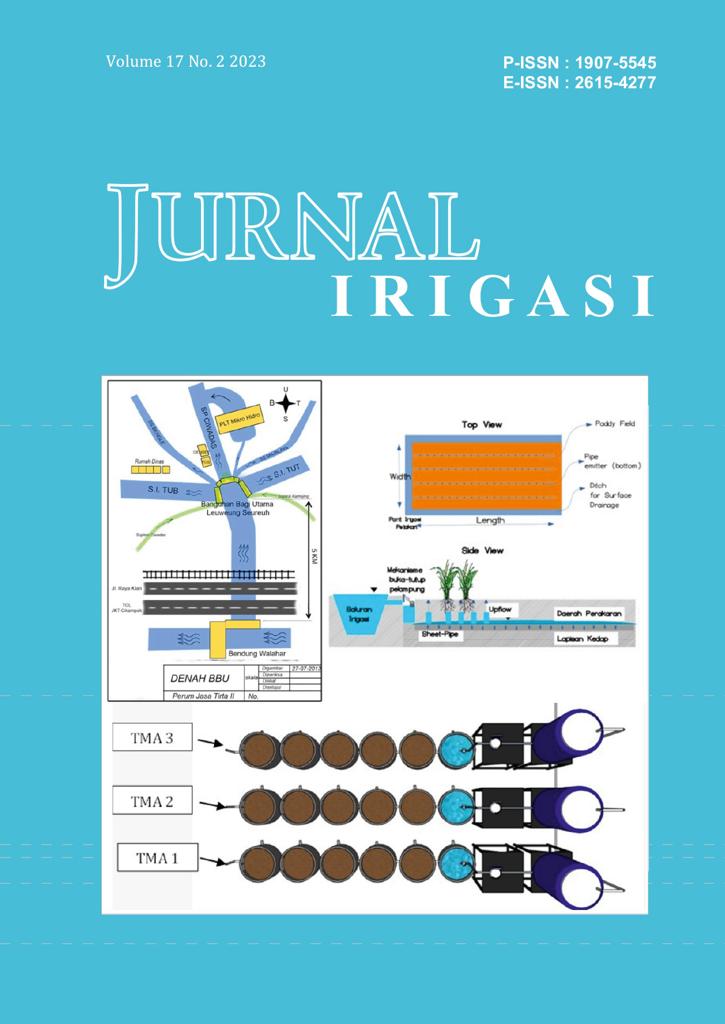The usage water flow model and UPFLOW software for evaporative irrigation evaluation of rice crops with different soil texture
DOI:
https://doi.org/10.31028/ji.v17.i2.12-21Keywords:
water flow model, UPFLOW software, Evaporative Irrigation, ET DemandAbstract
Subsurface irrigation using sheet-pipe requires determining the depth of sheet-pipe installation. The aim of this research is to determine the profile of groundwater rise in an evaporative irrigation system for three types of soil with different textures (at different locations), determine the capillary rise flux at these locations, and design the laying of the water supply pipe (water table) for the evaporative irrigation system effective. The locations chosen were Malang, Samosir and Lampung. Soil texture profiles from each of the three locations; silt loam-clay loam, clay-clay loam-clay, and silt loam-silt-loam-clay loam. Evaporative irrigation by providing water from below the root zone with a drainage pipe called sheet-pipe. The first stage was simulating capillarity water flow using a flow model. Simulation was carried out on existing texture, namely clay, clay loam and silt loam. The next stage was to use UPFLOW to determine the flux and determine the sheet-pipe position. At this stage, the ET demand for each phase of plant development was determined to be 1.2 mm/day (early stage), 2.6 mm/day (vegetative or development), 2.7 mm/day (fertilization), and 1.6 mm/day (seed maturation). Simulation shows that capillarity cannot keep up with ET demand, so the soil surface to a depth of around 5 cm shows low water content. The low water content was less than the critical water content. UPFLOW result shows that sheet pipes must be installed at different depths at the three locations to meet ET demand and sufficient aeration for rooting. The soil texture profile determines this depth.
Downloads
References
Ali, M. H., Abustan, I., & Islam, S. (2013). Simulation of upward flux from shallow water-table using UPFLOW model. Journal of Natural Resources and Development, 3, 123–127. https://doi.org/10.5027/jnrd.v3i0.12
Ardiansyah. (2008). Estimation of Evapotranspiration in Cultivated and Uncultivated Paddy Field in Tropical Watershed.” Doctoral Thesis, The University of Tokyo. (Doctoral Thesis). The University of Tokyo, Tokyo, Jepang.
Ardiansyah, Setiawan, B. I., Arif, C., & Saptomo, S. K. (2019). Peningkatan efisiensi aplikasi air pada petakan sawah dengan penerapan irigasi evaporatif (kajian teoritis). Jurnal Irigasi, 14(1), 47–54. http://dx.doi.org/10.31028/ji.v14.i1.46-53
Arif, C., Setiawan, B. I., Saptomo, S. K., Matsuda, H., Tamura, K., Inoue, Y., … Suwarno, W. B. (2021). Performances of sheet-pipe typed subsurface drainage on land and water productivity of paddy fields in Indonesia. Water, 13(1), 48. https://doi.org/10.3390/w13010048
Arif, C., Setiawan, B. I., Saptomo, S. K., Taufik, M., Saputra, S. F. D., Ardiansyah, & Mizoguchi, M. (2021). Functional design of smart evaporative irrigation for mina-padi system in Indonesia. IOP Conference Series: Earth and Environmental Science, 622(1), 012052. https://doi.org/ 10.1088/1755-1315/622/1/012052
Baihaqi, M. R. (2017). Perbedaan Karakteristik dan Klasifikasi Tanah Lahan Kering dan Lahan Sawah pada Bentuk Lahan Karst di Desa Sitiarjo Malang (Disertasi). Universitas Brawijaya, Malang, Indonesia.
Barrett, C. B., Moser, C. M., McHugh, O. V., & Barison, J. (2004). Better technology, better plots, or better farmers? Identifying changes in productivity and risk among Malagasy rice farmers. American Journal of Agricultural Economics, 86(4), 869–888. https://doi.org/10.1111/j.0002-9092.2004.00640.x
Ghanbarian-alavijeh, B., Liaghat, A., Huang, G. H., & Van genuchten, M. Th. (2010). Estimation of the van Genuchten Soil water retention properties from soil textural data. Pedosphere, 20(4), 456–465. https://doi.org/10.1016/S1002-0160(10)60035-5
Guellouz, L., Askri, B., Jaffré, J., & Bouhlila, R. (2020). Estimation of the soil hydraulic properties from field data by solving an inverse problem. Scientific Reports, 10(1), 9359. https://doi.org/10.1038/s41598-020-66282-5
Hasanah, N. A. I., Setiawan, B. I., Arif, C., & Widodo, S. (2015). Evaluasi koefisien tanaman padi pada berbagai perlakuan muka air. Jurnal Irigasi, 10(2), 57–68.
Hillel, D. (1998). Environmental Soil Physics: Fundamentals, Applications, and Environmental Considerations. Elsevier.
Kasno, A., Irawan, I., Husnain, H., & Rochayati, S. (2017). Integrated nutrient management of an acid paddy soil in Karang Tanjung Village, Padang Ratu, Central Lampung. Journal of Tropical Soils, 22(2), 97–106. https://doi.org/10.5400/jts. 2017.v22i2.97-106
Lubis, N. M. A., Nasution, Z., & Razali. (2017). Klasifikasi tanah lahan sawah terasering di Desa Huta Hotang Kecamatan Onan Runggu berdasarkan toposekuen. Jurnal Online Agroekoteknologi, 5(4), 764–772. https://doi.org/10.32734/ joa.v5i4.2489
Raes, D. (2003). UPFLOW: Model to assess water movement from a shallow water table to the root zone. IUPWARE’s Newsletter, 2, 15–17.
Raes, D., & Deproost, P. (2003). Model to assess water movement from a shallow water table to the root zone. Agricultural Water Management, 62(2), 79–91. https://doi.org/10.1016/S0378-3774(03) 00094-5
Saptomo, S. K., Rudiyanto, Askari, M., Arif, C., Suwarno, W. B., Adlan, … Matsuda, H. (2021). Experimental and numerical investigation of laboratory scale sheetpipe-typed automatic subsurface irrigation. Communications in Science and Technology, 6(2), 117–124. https://doi.org/10.21924/cst.6.2. 2021.604
Satyanarayana, A., Thiyagarajan, T. M., & Uphoff, N. (2006). Opportunities for water saving with higher yield from the system of rice intensification. Irrigation Science, 25(2), 99–115. https://doi.org/10.1007/s00271-006-0038-8
Tian, Z., Kool, D., Ren, T., Horton, R., & Heitman, J. L. (2019). Approaches for estimating unsaturated soil hydraulic conductivities at various bulk densities with the extended Mualem-van Genuchten model. Journal of Hydrology, 572, 719–731. https://doi.org/10.1016/j.jhydrol. 2019.03.027
Udom, I. J., & Nta, S. A. (2020). UPFLOW model prediction of capillary rise into root zone soil moisture for shallow water table soils of Obio Akpa river floodplain in the Niger-Delta environment, Nigeria. Agricultural Engineering International: CIGR Journal, 22(2), 21–31.
Uphoff, N. (2012). Comment to ‘The System of Rice Intensification: Time for an empirical turn’, [NJAS - Wageningen Journal of Life Sciences 57 (2011) 217–224]. NJAS: Wageningen Journal of Life Sciences, 59(1–2), 53–60. https://doi.org/ 10.1016/j.njas.2012.02.001
Vereecken, H., Weynants, M., Javaux, M., Pachepsky, Y., Schaap, M. G., & van Genuchten, M. Th. (2010). Using pedotransfer functions to estimate the van Genuchten–Mualem soil hydraulic properties: A review. Vadose Zone Journal, 9(4), 795–820. https://doi.org/10.2136/vzj2010.0045
Downloads
Published
How to Cite
Issue
Section
License
Copyright (c) 2023 Jurnal Irigasi

This work is licensed under a Creative Commons Attribution-ShareAlike 4.0 International License.
This work is licensed under a Creative Commons Attribution-ShareAlike 4.0 International License.
